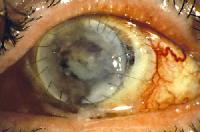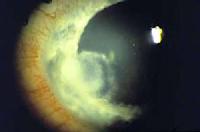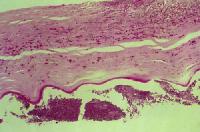|
Fungal keratitis remains a diagnostic and therapeutic challenge to the ophthalmologist. Difficulties are related to establishing a clinical diagnosis, isolating the etiologic fungal organism in the laboratory, and treating the keratitis effectively with topical antifungal agents. Moreover, the incidence of fungal keratitis has increased over the past 30 years. This increased occurrence of fungal keratitis is a result of the frequent use of topical corticosteroids and antibacterial agents in treating patients with keratitis, the rise in the number of patients who are immunocompromised, and better laboratory diagnostic techniques that aid in its diagnosis.
Pathophysiology: Many fungal organisms associated with ocular infections are ubiquitous, saprophytic organisms and have been reported as causes of infection only in the ophthalmic literature. Fungal isolates have been classified into the following groups: Moniliaceae (nonpigmented filamentary fungi, including Fusarium and Aspergillus species), Dematiaceae (pigmented filamentary fungi, including Curvularia and Lasiodiplodia species), and yeasts (including Candida species).

|
|
 |
|
A 68-year-old woman with a history of rheumatoid arthritis and lymphoma presented with decreased vision and pain in the left eye. She had undergone penetrating keratoplasty 5 weeks prior to presentation due to corneal melt. Culture results were positive for Paecilomyces specie and found in the home's basement.
|
. |
A 34-year-old man with no past medical history presented with decreased vision. The patient was working in his yard when a piece of wood hit his eye. Culture results were positive for Fusarium species
|
| |
|
|

|
|
Visit eMedicine for more information:

|
|
Photomicrograph of a corneal button reveals a large number of fungal elements in the corneal stroma and an associated endothelial plaque.
|
|
|
Fungi gain access into the corneal stroma through a defect in the epithelium, then multiply and cause tissue necrosis and an inflammatory reaction. The epithelial defect usually results from trauma (eg, contact lens wear, foreign material, prior corneal surgery). The organisms can penetrate an intact Descemet membrane and gain access into the anterior chamber or the posterior segment. Mycotoxins and proteolytic enzymes augment the tissue damage.
Fungal keratitis also has been described to occur secondary to fungal endophthalmitis. In these cases, fungal organisms extend from the posterior segment through the Descemet membrane and into the corneal strom
The incidence of fungal keratitis varies according to geographical location and ranges from 2% of keratitis cases in New York to 35% in Florida. Fusarium species are the most common cause of fungal corneal infection in the southern United States (45-76% of fungal keratitis), while Candida and Aspergillus species are more common in northern states.
In a recent large series of fungal keratitis from south Florida, Rosa et al reported that Fusarium oxysporum was the most common isolate (37%), followed by, in order of decreasing frequency, Fusarium solani (24%), Candida, Curvularia, and Aspergillus species.
|